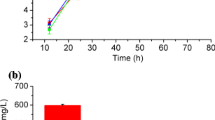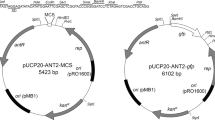Abstract
Pseudomonas sp. are predominant isolates of degradation-competent strains while very few studies have explored the degradation-related genes and pathways in most of the degrading strains. P. aeruginosa PAO1 was found capable of degrading naphthalene and phenanthrene efficiently. In order to investigate the degradation-related genes of naphthalene and phenanthrene in P. aeruginosa PAO1, a random promoter library of about 5760 strains was constructed. Thirty-two clones for differentially expressed promoters were obtained by screening in the presence of sub-inhibitory concentration of naphthalene and phenanthrene. Among them, 13 genes were up-regulated and 15 were down-regulated in the presence of naphthalene as well as phenanthrene. The four remaining genes have different regulation tendencies by naphthalene or phenanthrene. By comparing the growth between the wild type and mutants as well as the complementations, the roles of seven selected up-regulated genes on naphthalene and phenanthrene degradation were investigated. Five of the seven selected up-regulated genes, like PA2666 and PA4780, were found playing key roles on the degradation in P. aeruginosa PAO1. Also, the results imply that these genes participate in the overlapping part of naphthalene and phenanthrene degradation pathways in PAO1. Results in the article offer the convenience quick method and platform for searching degradation-related genes. It also laid a foundation for understanding of the role of the regulated genes.







Similar content being viewed by others
References
Adhikari P, Kirby SD, Nowalk AJ, Veraldi KL, Schryvers AB, Mietzner TA (1995) Biochemical characterization of a Haemophilus influenzae periplasmic iron transport operon. J Biol Chem 270:25142–25149
Annweiler E, Richnow H, Antranikian G, Hebenbrock S, Garms C, Franke S, Francke W, Michaelis W (2000) Naphthalene degradation and incorporation of naphthalene-derived carbon into biomass by the thermophile Bacillus thermoleovorans. Appl Environ Microbiol 66:518–523
Balashova N, Stolz A, Knackmuss H, Kosheleva I, Naumov A, Boronin A (2001) Purification and characterization of a salicylate hydroxylase involved in 1-hydroxy-2-naphthoic acid hydroxylation from the naphthalene and phenanthrene-degrading bacterial strain Pseudomonas putida BS202-P1. Biodegradation 12:179–188
Banat I (2011) Effect of biosurfactant and fertilizer on biodegradation of crude oil by marine isolates of Bacillus megaterium, Corynebacterium kutscheri and Pseudomonas aeruginosa. Bioresour Technol 102:772–778
Blau N (1998) Structure, genomic localization and recombinant expression of the mouse 6-pyruvoyl-tetrahydropterin synthase gene. Biol Chem 379:1441–1447
Bogan BW, Lamar RT (1995) One-electron oxidation in the degradation of creosote polycyclic aromatic hydrocarbons by Phanerochaete chrysosporium. Appl Environ Microbiol 61:2631–2635
Cerniglia CE (1992) Biodegradation of polycyclic aromatic hydrocarbons. Biodegradation 3:351–368
Churchill SA, Harper JP, Churchill PF (1999) Isolation and characterization of a mycobacterium species capable of degrading three-and four-ring aromatic and aliphatic hydrocarbons. Appl Environ Microbiol 65:549–552
Coral G, Karagoz S (2005) Isolation and characterization of phenanthrene-degrading bacteria from a petroleum refinery soil. Ann Microbiol 55:255
Denome S, Stanley D, Olson E, Young K (1993) Metabolism of dibenzothiophene and naphthalene in Pseudomonas strains: complete DNA sequence of an upper naphthalene catabolic pathway. J Bacteriol 175:6890–6901
Déziel E, Lépine F, Dennie D, Boismenu D, Mamer O, Villemur R (1999) Liquid chromatography/mass spectrometry analysis of mixtures of rhamnolipids produced by Pseudomonas aeruginosa strain 57RP grown on mannitol or naphthalene. Biochim Biophys Acta 1440:244–252
Ditta G, Stanfield S, Corbin D, Helinski DR (1980) Broad host range DNA cloning system for gram-negative bacteria: construction of a gene bank of Rhizobium meliloti. Proc Natl Acad Sci 77:7347–7351
Duan K, Dammel C, Stein J, Rabin H, Surette MG (2003) Modulation of Pseudomonas aeruginosa gene expression by host microflora through interspecies communication. Mol Microbiol 50:1477–1491
Fuenmayor SL, Wild M, Boyes AL, Williams PA (1998) A gene cluster encoding steps in conversion of naphthalene to gentisate in Pseudomonas sp. strain U2. J Bacteriol 180:2522–2530
Geiselbrecht AD, Hedlund BP, Tichi MA, Staley JT (1998) Isolation of marine polycyclic aromatic hydrocarbon (PAH)-degrading Cycloclasticus strains from the Gulf of Mexico and comparison of their PAH degradation ability with that of Puget Sound Cycloclasticus strains. Appl Environ Microbiol 64:4703–4710
Hearn EM, Dennis JJ, Gray MR, Foght JM (2003) Identification and characterization of the emhABC efflux system for polycyclic aromatic hydrocarbons in Pseudomonas fluorescens cLP6a. J Bacteriol 185:6233–6240
Hoang T, Karkhoff-Schweizer R, Kutchma A, Schweizer H (1998) A broad-host-range Flp-FRT recombination system for site-specific excision of chromosomally-located DNA sequences: application for isolation of unmarked Pseudomonas aeruginosa mutants. Gene 212:77–86
Holloway B (1955) Genetic recombination in Pseudomonas aeruginosa. J Gen Microbiol 13:572–581
Honisch U, Zumft WG (2003) Operon structure and regulation of the nos gene region of Pseudomonas stutzeri, encoding an ABC-type ATPase for maturation of nitrous oxide reductase. J Bacteriol 185:1895–1902
Iwabuchi T, Harayama S (1997) Biochemical and genetic characterization of 2-carboxybenzaldehyde dehydrogenase, an enzyme involved in phenanthrene degradation by Nocardioides sp. strain KP7. J Bacteriol 179:6488–6494
Kasai Y., Shindo K., Harayama S., Misawa N. (2003) Molecular characterization and substrate preference of a polycyclic aromatic hydrocarbon dioxygenase from Cycloclasticus sp. strain A5. Appl Environ Microbiol 69, 6688–6697
Khan AA, Wang R-F, Cao W-W, Doerge DR, Wennerstrom D, Cerniglia CE (2001) Molecular cloning, nucleotide sequence, and expression of genes encoding a polycyclic aromatic ring dioxygenase from Mycobacterium sp. strain PYR-1. Appl Environ Microbiol 67:3577–3585
Kim YH, Cho K, Yun SH, Kim JY, Kwon KH, Yoo JS, Kim SI (2006) Analysis of aromatic catabolic pathways in Pseudomonas putida KT 2440 using a combined proteomic approach: 2-DE/MS and cleavable isotope-coded affinity tag analysis. Proteomics 6:1301–1318
Kiyohara H, Nagao K, Kouno K, Yano K (1982) Phenanthrene-degrading phenotype of Alcaligenes faecalis AFK2. Appl Environ Microbiol 43:458–461
Kluge C, Brecevic L, Heizmann CW, Blau N, Thöny B (1996) Chromosomal localization, genomic structure and characterization of the human gene and a retropseudogene for 6-pyruvoyltetrahydropterin synthase. Eur J Biochem 240:477–484
Laurie A.D., Lloyd-Jones G. (1999) The phn Genes of Burkholderia sp. Strain RP007 constitute a divergent gene cluster for polycyclic aromatic hydrocarbon catabolism. Journal of bacteriology 181, 531-540
Lee S., Cutright T.J., (1996) Nutrient medium for the bioremediation of polycyclic aromatic hydrocarbon-contaminated soil. Google Patents
Ma Y, Wang L, Shao Z (2006) Pseudomonas, the dominant polycyclic aromatic hydrocarbon-degrading bacteria isolated from Antarctic soils and the role of large plasmids in horizontal gene transfer. Environ Microbiol 8:455–465
Ma C, Wang Y, Zhuang L, Huang D, Zhou S, Li F (2011) Anaerobic degradation of phenanthrene by a newly isolated humus-reducing bacterium, Pseudomonas aeruginosa strain PAH-1. J Soils Sediments 11:923–929
Moody J.D., Freeman J.P., Doerge D.R., Cerniglia C.E. (2001) Degradation of phenanthrene and anthracene by cell suspensions of Mycobacterium sp. strain PYR-1. Appl Environ Microbiol 67, 1476-1483
Pagnout C, Frache G, Poupin P, Maunit B, Muller J-F, Férard J-F (2007) Isolation and characterization of a gene cluster involved in PAH degradation in Mycobacterium sp. strain SNP11: expression in Mycobacterium smegmatis mc2155. Res Microbiol 158:175–186
Peng RH, Xiong AS, Xue Y, Fu XY, Gao F, Zhao W, Tian YS, Yao QH (2008) Microbial biodegradation of polyaromatic hydrocarbons. FEMS Microbiol Rev 32:927–955
Pinyakong O., Habe H., Supaka N., Pinpanichkarn P., Juntongjin K., Yoshida T., Furihata K., Nojiri H., Yamane H., Omori T. (2000) Identification of novel metabolites in the degradation of phenanthrene by Sphingomonas sp. strain P2. FEMS microbiology letters 191, 115-121
Pinyakong O., Habe H., Yoshida T., Nojiri H., Omori T. (2003) Identification of three novel salicylate 1-hydroxylases involved in the phenanthrene degradation of Sphingobium sp. strain P2. Biochemical and biophysical research communications 301, 350-357
Qu Y, Zhang X, Ma Q, Ma F, Zhang Q, Li X, Zhou H, Zhou J (2012) Indigo biosynthesis by Comamonas sp. MQ Biotechnol Lett 34:353–357
Ramos JL, Duque E, Gallegos M-T, Godoy P, Ramos-González MI, Rojas A, Terán W, Segura A (2002) Mechanisms of solvent tolerance in gram-negative bacteria. Ann Rev Microbiol 56:743–768
Romero-Silva MJ, Méndez V, Agulló L, Seeger M (2013) Genomic and functional analyses of the gentisate and protocatechuate ring-cleavage pathways and related 3-hydroxybenzoate and 4-hydroxybenzoate peripheral pathways in Burkholderia xenovorans LB400. PLoS ONE 8:e56038
Romine MF, Stillwell LC, Wong K-K, Thurston SJ, Sisk EC, Sensen C, Gaasterland T, Fredrickson JK, Saffer JD (1999) Complete sequence of a 184-kilobase catabolic plasmid from Sphingomonas aromaticivorans F199. J Bacteriol 181:1585–1602
Samanta SK, Chakraborti AK, Jain RK (1999) Degradation of phenanthrene by different bacteria: evidence for novel transformation sequences involving the formation of 1-naphthol. Appl Microbiol Biotechnol 53:98–107
Sang Y, Xiong G, Maser E (2011) Steroid degradation and two steroid-inducible enzymes in the marine bacterium H5. Chem Biol Interact 191:89–94
Schweizer H (1993) Two plasmids, X1918 and Z1918, for easy recovery of the xylE and lacZ reporter genes. Gene 134:89
Seo JS, Keum YS, Li QX (2009) Bacterial degradation of aromatic compounds. Int J Environ Res Public Health 6:278–309
Sharma S, Pathak H (2014) Pseudomonas in biodegradation. Int J Pure App Biosci 2:213–222
Sharp R, Jansons I, Gertman E, Kropinski A (1996) Genetic and sequence analysis of the cos region of the temperate Pseudomonas aeruginosa bacteriophage, D3. Gene 177:47–53
Sikkema J, De Bont J, Poolman B (1995) Mechanisms of membrane toxicity of hydrocarbons. Microbiol Rev 59:201–222
Simon R, Priefer U, Pühler A (1983) A broad host range mobilization system for in vivo genetic engineering: transposon mutagenesis in gram negative bacteria. Nat Biotechnol 1:784–791
Simon M, Osslund T, Saunders R, Ensley B, Suggs S, Harcourt A, Suen W, Cruden D, Gibson D, Zylstra G (1993) Sequences of genes encoding naphthalene dioxygenase in Pseudomonas putida strains G7 and NCIB 9816-4. Gene 127:31
Stingley R, Khan A, Cerniglia C (2004) Molecular characterization of a phenanthrene degradation pathway in Mycobacterium vanbaalenii PYR-1. Biochem Biophys Res Commun 322:133–146
Supaka N., Pinphanichakarn P., Pattaragulwanit K., Thaniyavarn S., Omori T., Juntongjin K. (2001) Isolation and characterization of a phenanthrene-degrading Sphingomonas sp. strain P2 and its ability to degrade fluoranthene and pyrene via cometabolism. Sci. Asia 27, 21-28
Wu G, Williams HD, Zamanian M, Gibson F, Poole RK (1992) Isolation and characterization of Escherichia coli mutants affected in aerobic respiration: the cloning and nucleotide sequence of ubiG Identification of an S-adenosylmethionine-binding motif in protein, RNA, and small-molecule methyltransferases. J Gen Microbiol 138:2101–2112
Acknowledgments
This work was supported by NSFC (Grant No: 81171620, 1210063), PCSIRT (No. IRT1174), Shaanxi Provincial Government (No. 11JK0611) and the Western Resource Biology and Mordern Biological Technology Llab Open Foundation (ZS11007).
Author information
Authors and Affiliations
Corresponding author
Additional information
Responsible editor: Philippe Garrigues
Rights and permissions
About this article
Cite this article
Qi, J., Wang, B., Li, J. et al. Genetic determinants involved in the biodegradation of naphthalene and phenanthrene in Pseudomonas aeruginosa PAO1. Environ Sci Pollut Res 22, 6743–6755 (2015). https://doi.org/10.1007/s11356-014-3833-4
Received:
Accepted:
Published:
Issue Date:
DOI: https://doi.org/10.1007/s11356-014-3833-4




